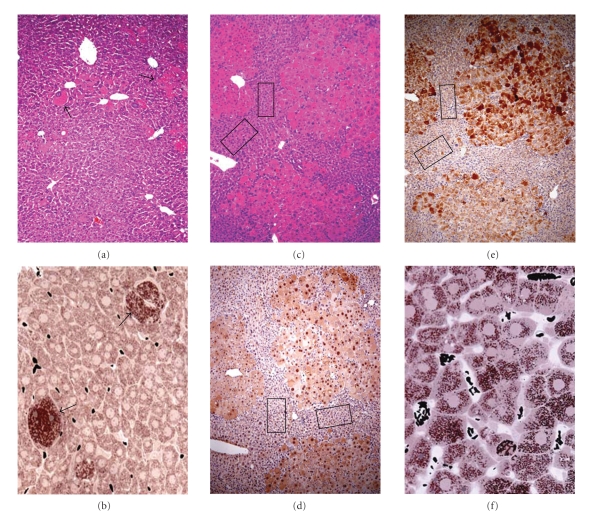Figure 3.
Effects of Med1 and PRIP deletion on PPARα ligand-induced pleiotropic responses in liver. Med1ΔLiv mice treated with Wy-14,643 (0.125% wt/wt) for 2 weeks (a, b) show an occasional hepatocyte that escaped Alb-Cre mediated deletion of Med1 floxed alleles. These Med1 positive hepatocytes respond to the peroxisome proliferative effects of PPARα-ligand (arrows indicate to Med1+/+ cells with numerous peroxisomes) but not the majority of Med1−/− hepatocytes. Chronic treatment of Med1ΔLiv mice with 0.02% Wy-14,643 for 5 months (c–e) results in clonal expansion of residual Med1fl/fl cells as demonstrated by H&E staining (c). In contrast, the adjacent hepatocyte lacking Med1 are generally smaller than normal hepatocytes (see boxed area in c). Immunohistochemical localization of Med1 reveals that expanding colonies of large hepatocytes are Med1 positive (nuclear Med1 in panel d). These cells also show abundant cytoplasmic expression of L-PBE, the second enzyme of the peroxisomal fatty acid β-oxidation system (panel e), whereas the smaller Med1 null hepatocytes (boxed areas) fail to show L-PBE induction (panel e). Disruption of coactivator PRIP in hepatocytes does not interfere with PPARα ligand-induced peroxisome proliferation as evidenced by the abundant catalase positive peroxisomes (brown dots) in all hepatocytes (panel f). Compare this panel (f) with panel (b) in which only an occasional Med1+/+ cell responds to PPARα ligand.

